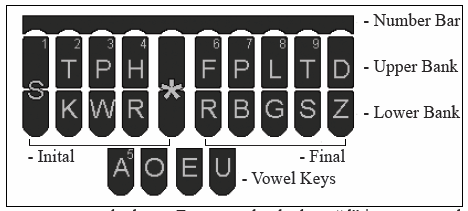From the TCG Archives (March 2005)
Throwing it back to the early
How a Steno Machine Works
The keyboard of a steno machine is divided into a number of major groupings, shown in the illustration below.

You may be thinking… there aren’t enough letters on the keyboard to write down everything that is being said! But there are. The keys are pressed down in groups to create different sounds. Words are written phonetically, so, for example, all words beginning with the letter “c” have a hard “k” sound (car, cat, coat) or an “s” sound (certain, cement, ceremony), so they are written with the K or the S.
For some letters, you must strike two or more keys to represent the letter. For example, the letter “d” is represented by striking TK together.
There is an initial side of consonants which are used to begin words and a final side of consonants which are used to end words. The vowels are written in between. The vowel “i” is written by striking the EU together.
For some letters, you must strike two or more keys to represent the letter. For example, the letter “d” is represented by striking TK together.
There is an initial side of consonants which are used to begin words and a final side of consonants which are used to end words. The vowels are written in between. The vowel “i” is written by striking the EU together.
A Look at the History
The Stenograph Shorthand, 1879- Miles Bartholomew invented the first successful shorthand machine in 1877. Improvements were later made to the machine and patents were obtained for it in 1879 and 1884.
It was manufactured by Bartholomew’s company, the United States Stenograph Corporation of East St. Louis, Illinois, and was used as late as 1937 by official reporters. The ten keys could be depressed one at a time (a letter at a stroke) to create a series of dots and dashes, much like Morse Code. A native of Belleville, Illinois, Bartholomew was an official court reporter and is considered the “Father of the Stenograph.” The Bartholomew Stenograph was the first machine to attain a degree of success in the reporting field. Many machines were manufactured, and some schools taught its operation. The venture was not a financial success, however, but Bartholomew remained supportive of machine shorthand. In 1883, he wrote, “The old prejudices against machine stenography are giving way to confidence in, and
courtesy of the National Court Reporters Association






